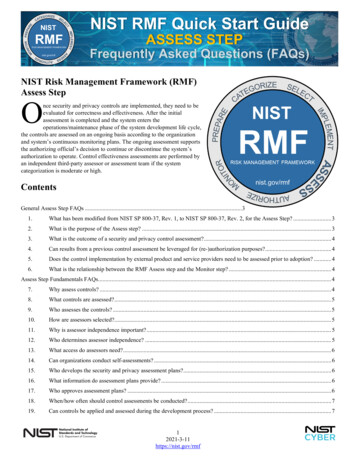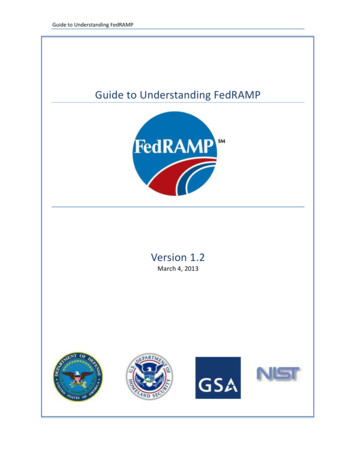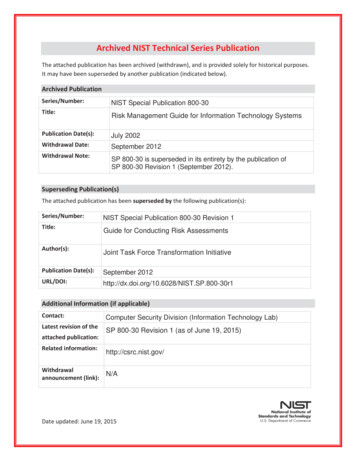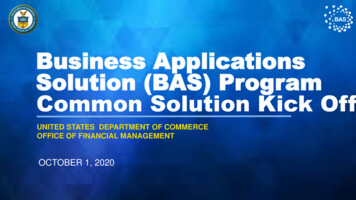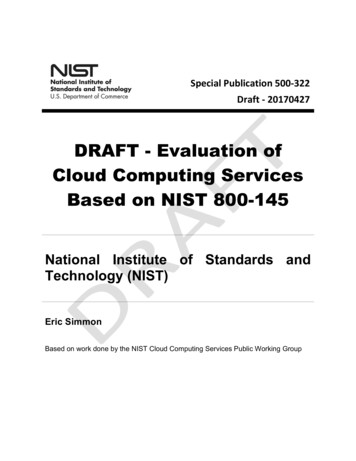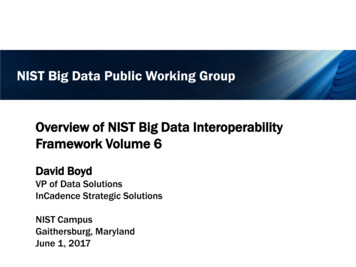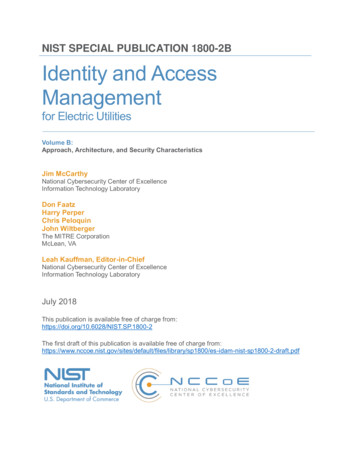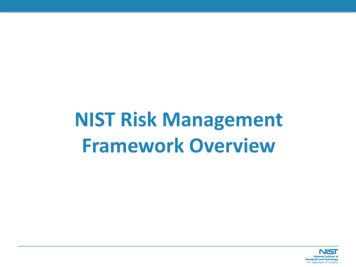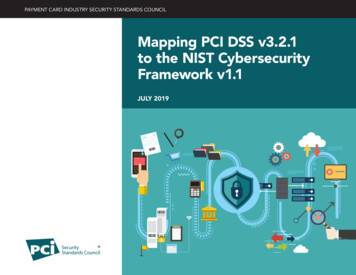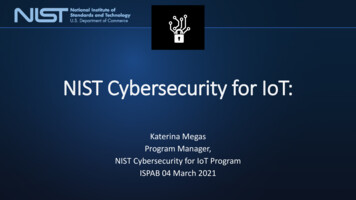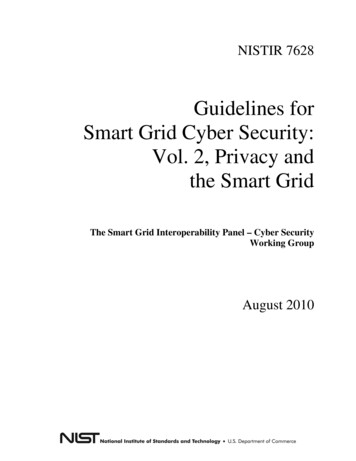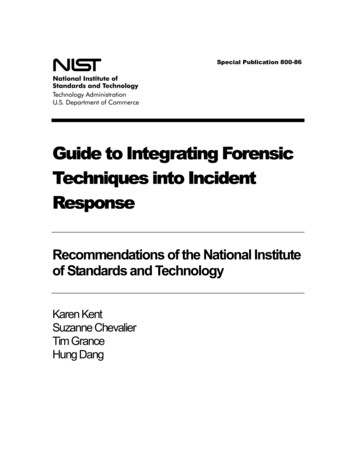
Transcription
Special Publication 800-86Guide to Integrating ForensicTechniques into IncidentResponseRecommendations of the National Instituteof Standards and TechnologyKaren KentSuzanne ChevalierTim GranceHung Dang
NIST Special Publication 800-86Guide to Integrating Forensic Techniquesinto Incident ResponseRecommendations of the NationalInstitute of Standards and TechnologyKaren Kent, Suzanne Chevalier,Tim Grance, Hung DangC O M P U T E RS E C U R I T YComputer Security DivisionInformation Technology LaboratoryNational Institute of Standards and TechnologyGaithersburg, MD 20899-8930August 2006U.S. Department of CommerceCarlos M. Gutierrez, SecretaryTechnology AdministrationRobert C. Cresanti, Under Secretary ofCommerce for TechnologyNational Institute of Standards and TechnologyWilliam A. Jeffrey, Director
GUIDE TO INTEGRATING FORENSIC TECHNIQUES INTO INCIDENT RESPONSEReports on Computer Systems TechnologyThe Information Technology Laboratory (ITL) at the National Institute of Standards and Technology(NIST) promotes the U.S. economy and public welfare by providing technical leadership for the nation’smeasurement and standards infrastructure. ITL develops tests, test methods, reference data, proof ofconcept implementations, and technical analysis to advance the development and productive use ofinformation technology. ITL’s responsibilities include the development of technical, physical,administrative, and management standards and guidelines for the cost-effective security and privacy ofsensitive unclassified information in Federal computer systems. This Special Publication 800-seriesreports on ITL’s research, guidance, and outreach efforts in computer security and its collaborativeactivities with industry, government, and academic organizations.National Institute of Standards and Technology Special Publication 800-86Natl. Inst. Stand. Technol. Spec. Publ. 800-86, 121 pages (August 2006)Certain commercial entities, equipment, or materials may be identified in thisdocument in order to describe an experimental procedure or concept adequately.Such identification is not intended to imply recommendation or endorsement by theNational Institute of Standards and Technology, nor is it intended to imply that theentities, materials, or equipment are necessarily the best available for the purpose.ii
GUIDE TO INTEGRATING FORENSIC TECHNIQUES INTO INCIDENT RESPONSEAcknowledgmentsThe authors, Karen Kent and Tim Grance of the National Institute of Standards and Technology, andSuzanne Chevalier and Hung Dang of Booz Allen Hamilton, wish to thank their colleagues who revieweddrafts of this document and contributed to its technical content. The authors would particularly like toacknowledge Rick Ayers, Wayne Jansen, Peter Mell, and Murugiah Souppaya of NIST, and AdamFeldman, Mike Noblett, and Joseph Nusbaum of Booz Allen Hamilton, for their keen and insightfulassistance throughout the development of the document. The authors would also like to express theirthanks to security experts Susan Ballou (Office of Law Enforcement Standards), Brian Carrier (PurdueUniversity), Eoghan Casey (Stroz Friedberg, LLC), Duane Crider (Microsoft), Kurt Dillard (Microsoft),Dean Farrington (Wells Fargo Bank), Jessica Reust (Stroz Friedberg, LLC), Marc Rogers (PurdueUniversity), and Miles Tracy (U.S. Federal Reserve System), as well as representatives from theDepartment of State, for their particularly valuable comments and suggestions.TrademarksAll product names are registered trademarks or trademarks of their respective companies.iii
GUIDE TO INTEGRATING FORENSIC TECHNIQUES INTO INCIDENT RESPONSETable of ContentsExecutive Summary .ES-11.Introduction . 1-11.11.21.31.42.Establishing and Organizing a Forensics Capability. 2-12.12.22.32.42.52.63.3.23.33.43.5Data Collection. 3-23.1.1 Identifying Possible Sources of Data . 3-23.1.2 Acquiring the Data. 3-33.1.3 Incident Response Considerations. 3-5Examination . 3-6Analysis. 3-6Reporting. 3-6Recommendations . 3-7Using Data from Data Files . 4-14.14.24.34.44.55.The Need for Forensics . 2-1Forensic Staffing . 2-3Interactions with Other Teams. 2-4Policies. 2-52.4.1 Defining Roles and Responsibilities . 2-52.4.2 Providing Guidance for Forensic Tool Use . 2-62.4.3 Supporting Forensics in the Information System Life Cycle. 2-6Guidelines and Procedures . 2-7Recommendations . 2-8Performing the Forensic Process . 3-13.14.Authority. 1-1Purpose and Scope. 1-1Audience . 1-1Publication Structure . 1-2File Basics. 4-14.1.1 File Storage Media . 4-14.1.2 Filesystems . 4-34.1.3 Other Data on Media. 4-4Collecting Files. 4-54.2.1 Copying Files from Media. 4-64.2.2 Data File Integrity . 4-74.2.3 File Modification, Access, and Creation Times . 4-94.2.4 Technical Issues . 4-9Examining Data Files. 4-104.3.1 Locating the Files . 4-114.3.2 Extracting the Data. 4-114.3.3 Using a Forensic Toolkit. 4-13Analysis. 4-14Recommendations . 4-15Using Data from Operating Systems . 5-15.1OS Basics . 5-1iv
GUIDE TO INTEGRATING FORENSIC TECHNIQUES INTO INCIDENT RESPONSE5.25.35.46.Using Data From Network Traffic . 6-16.16.26.36.46.57.5.1.1 Non-Volatile Data . 5-15.1.2 Volatile Data. 5-3Collecting OS Data. 5-45.2.1 Collecting Volatile OS Data . 5-55.2.2 Collecting Non-Volatile OS Data . 5-85.2.3 Technical Issues with Collecting Data . 5-10Examining and Analyzing OS Data. 5-11Recommendations . 5-12TCP/IP Basics . 6-16.1.1 Application Layer. 6-26.1.2 Transport Layer. 6-26.1.3 IP Layer . 6-36.1.4 Hardware Layer. 6-46.1.5 Layers’ Significance in Network Forensics . 6-4Network Traffic Data Sources. 6-56.2.1 Firewalls and Routers. 6-56.2.2 Packet Sniffers and Protocol Analyzers. 6-56.2.3 Intrusion Detection Systems. 6-66.2.4 Remote Access. 6-76.2.5 Security Event Management Software . 6-76.2.6 Network Forensic Analysis Tools . 6-86.2.7 Other Sources. 6-8Collecting Network Traffic Data . 6-96.3.1 Legal Considerations . 6-96.3.2 Technical Issues . 6-10Examining and Analyzing Network Traffic Data . 6-116.4.1 Identify an Event of Interest. 6-126.4.2 Examine Data Sources. 6-126.4.3 Draw Conclusions . 6-166.4.4 Attacker Identification. 6-17Recommendations . 6-18Using Data from Applications . 7-17.17.27.3Application Components. 7-17.1.1 Configuration Settings. 7-17.1.2 Authentication . 7-27.1.3 Logs . 7-27.1.4 Data . 7-37.1.5 Supporting Files . 7-37.1.6 Application Architecture. 7-4Types of Applications . 7-57.2.1 E-mail. 7-57.2.2 Web Usage . 7-67.2.3 Interactive Communications . 7-77.2.4 File Sharing. 7-77.2.5 Document Usage . 7-87.2.6 Security Applications. 7-87.2.7 Data Concealment Tools. 7-8Collecting Application Data. 7-9v
GUIDE TO INTEGRATING FORENSIC TECHNIQUES INTO INCIDENT RESPONSE7.47.58.Examining and Analyzing Application Data. 7-9Recommendations . 7-10Using Data from Multiple Sources . 8-18.18.28.3Suspected Network Service Worm Infection. 8-1Threatening E-mail . 8-3Recommendations . 8-5List of AppendicesAppendix A— Recommendations.A-1A.1 Organizing a Forensics Capability . A-1A.1.1 Forensic Participants. A-1A.1.2 Forensic Policies, Guidelines, and Procedures. A-1A.1.3 Technical Preparation . A-2A.2 Performing the Forensics Process. A-2A.2.1 Data Collection. A-3A.2.2 Examination and Analysis . A-4A.2.3 Reporting . A-4Appendix B— Scenarios.B-1B.1 Scenario Questions . B-1B.2 Scenarios . B-1Appendix C— Glossary .C-1Appendix D— Acronyms .D-1Appendix E— Print Resources. E-1Appendix F— Online Tools and Resources . F-1Appendix G— Index .G-1List of FiguresFigure 3-1. Forensic Process . 3-1Figure 4-1. File Header Information. 4-12Figure 6-1. TCP/IP Layers. 6-1Figure 6-2. TCP/IP Encapsulation . 6-2List of TablesTable 4-1. Commonly Used Media Types . 4-2vi
GUIDE TO INTEGRATING FORENSIC TECHNIQUES INTO INCIDENT RESPONSEExecutive SummaryForensic science is generally defined as the application of science to the law. Digital forensics, alsoknown as computer and network forensics, has many definitions. Generally, it is considered theapplication of science to the identification, collection, examination, and analysis of data while preservingthe integrity of the information and maintaining a strict chain of custody for the data. Data refers todistinct pieces of digital information that have been formatted in a specific way. Organizations have anever-increasing amount of data from many sources. For example, data can be stored or transferred bystandard computer systems, networking equipment, computing peripherals, personal digital assistants(PDA), consumer electronic devices, and various types of media, among other sources.Because of the variety of data sources, digital forensic techniques can be used for many purposes, such asinvestigating crimes and internal policy violations, reconstructing computer security incidents,troubleshooting operational problems, and recovering from accidental system damage. Practically everyorganization needs to have the capability to perform digital forensics (referred to as forensics throughoutthe rest of the guide). Without such a capability, an organization will have difficulty determining whatevents have occurred within its systems and networks, such as exposures of protected, sensitive data.This guide provides detailed information on establishing a forensic capability, including the developmentof policies and procedures. Its focus is primarily on using forensic techniques to assist with computersecurity incident response, but much of the material is also applicable to other situations.Because different organizations are subject to different laws and regulations, this publicationshould not be used as a guide to executing a digital forensic investigation, construed as legal advice,or used as the basis for investigations of criminal activity.1 Instead, organizations should use thisguide as a starting point for developing a forensic capability in conjunction with extensive guidanceprovided by legal advisors, law enforcement officials, and management.The process for performing digital forensics comprises the following basic phases:! Collection: identifying, labeling, recording, and acquiring data from the possible sources ofrelevant data, while following procedures that preserve the integrity of the data.! Examination: forensically processing collected data using a combination of automated andmanual methods, and assessing and extracting data of particular interest, while preserving theintegrity of the data.! Analysis: analyzing the results of the examination, using legally justifiable methods andtechniques, to derive useful information that addresses the questions that were the impetus forperforming the collection and examination.! Reporting: reporting the results of the analysis, which may include describing the actions used,explaining how tools and procedures were selected, determining what other actions need to beperformed (e.g., forensic examination of additional data sources, securing identifiedvulnerabilities, improving existing security controls), and providing recommendations forimprovement to policies, procedures, tools, and other aspects of the forensic process.This guide provides general recommendations for performing the forensic process. It also providesdetailed information about using the analysis process with four major categories of data sources: files,1For further information regarding computer and network forensic requirements for law enforcement, see Electronic CrimeScene Investigation: A Guide for First Responders and Forensic Examination of Digital Evidence: A Guide for LawEnforcement, which are both available at http://www.ncjrs.gov/ by searching on each document’s title.ES-1
GUIDE TO INTEGRATING FORENSIC TECHNIQUES INTO INCIDENT RESPONSEoperating systems, network traffic, and applications. The guide focuses on explaining the basiccomponents and characteristics of data sources within each category, as well as techniques for thecollection, examination, and analysis of data from each category. The guide also providesrecommendations for how multiple data sources can be used together to gain a better understanding of anevent.Implementing the following recommendations should facilitate efficient and effective digital forensicactivities for Federal departments and agencies.Organizations should ensure that their policies contain clear statements addressing all majorforensic considerations, such as contacting law enforcement, performing monitoring, andconducting regular reviews of forensic policies and procedures.At a high level, policies should allow authorized personnel to monitor systems and networks and performinvestigations for legitimate reasons under appropriate circumstances. Organizations may also have aseparate forensic policy for incident handlers and others with forensic roles; this policy would providemore detailed rules concerning appropriate behavior. Forensic policy should clearly define the roles andresponsibilities of all people and external organizations performing or assisting with the organization’sforensic activities. The policy should clearly indicate who should contact which internal teams andexternal organizations under different circumstances.Organizations should create and maintain procedures and guidelines for performing forensic tasks,based on the organization’s policies and all applicable laws and regulations.Guidelines should focus on general methodologies for investigating incidents using forensic techniques,since it is not feasible to develop comprehensive procedures tailored to every possible situation.However, organizations should consider developing step-by-step procedures for performing routine tasks.The guidelines and procedures should facilitate consistent, effective, and accurate actions, which isparticularly important for incidents that may lead to prosecution or internal disciplinary actions; handlingevidence in a forensically sound manner puts decision makers in a position where they can confidentlytake the necessary actions. The guidelines and procedures should support the admissibility of evidenceinto legal proceedings, including information on gathering and handling evidence properly, preserving theintegrity of tools and equipment, maintaining the chain of custody, and storing evidence appropriately.Because electronic logs and other records can be altered or otherwise manipulated, organizations shouldbe prepared, through their policies, guidelines, and procedures, to demonstrate the integrity of suchrecords. The guidelines and procedures should be reviewed periodically, as well as when significantchanges are made to the team’s policies and procedures.Organizations should ensure that their policies and procedures support the reasonable andappropriate use of forensic tools.Organizations’ policies and procedures should clearly explain what forensic actions should and should notbe performed under various circumstances, as well as describing the necessary safeguards for sensitiveinformation that might be recorded by forensic tools, such as passwords, personal data (e.g., SocialSecurity numbers), and the contents of e-mails. Legal advisors should carefully review all forensic policyand high-level procedures.Organizations should ensure that their IT professionals are prepared to participate in forensicactivities.ES-2
GUIDE TO INTEGRATING FORENSIC TECHNIQUES INTO INCIDENT RESPONSEIT professionals throughout an organization, especially incident handlers and other first responders toincidents, should understand their roles and responsibilities for forensics, receive training and educationon forensic–related policies and procedures, and be prepared to cooperate with and assist others when thetechnologies that they are responsible for are part of an incident or other event. IT professionals shouldalso consult closely with legal counsel both in general preparation for forensics activities, such asdetermining which actions IT professionals should and should not perform, and also on an as-neededbasis to discuss specific forensics situations. In addition, management should be responsible forsupporting forensic capabilities, reviewing and approving forensic policy, and approving certain forensicactions, such as taking mission-critical systems off-line.ES-3
GUIDE TO INTEGRATING FORENSIC TECHNIQUES INTO INCIDENT RESPONSEThis page has been left blank intentionally.ES-4
GUIDE TO INTEGRATING FORENSIC TECHNIQUES INTO INCIDENT RESPONSE1.Introduction1.1AuthorityThe National Institute of Standards and Technology (NIST) developed this document in furtherance of itsstatutory responsibilities under the Federal Information Security Management Act (FISMA) of 2002,Public Law 107-347.NIST is responsible for developing standards and guidelines, including minimum requirements, forproviding adequate information security for all agency operations and assets; but such standards andguidelines shall not apply to national security systems. This guideline is consistent with the requirementsof the Office of Management and Budget (OMB) Circular A-130, Section 8b(3), “Securing AgencyInformation Systems,” as analyzed in A-130, Appendix IV: Analysis of Key Sections. Supplementalinformation is provided in A-130, Appendix III.This guideline has been prepared for use by Federal agencies. It may be used by nongovernmentalorganizations on a voluntary basis and is not subject to copyright, though attribution is desired.Nothing in this document should be taken to contradict standards and guidelines made mandatory andbinding on Federal agencies by the Secretary of Commerce under statutory authority, nor should theseguidelines be interpreted as altering or superseding the existing authorities of the Secretary of Commerce,Director of the OMB, or any other Federal official.This guideline should not be held as binding to law enforcement personnel relative to theinvestigation of criminal activity.1.2Purpose and ScopeThis publication is intended to help organizations in investigating computer security incidents andtroubleshooting some information technology (IT) operational problems by providing practical guidanceon performing computer and network forensics. The guide presents forensics from an IT view, not alaw enforcement view.2 Specifically, the publication describes the processes for performing effectiveforensics activities and provides advice regarding different data sources, including files, operatingsystems (OS), network traffic, and applications.The publication is not to be used as an all-inclusive step-by-step guide for executing a digital forensicinvestigation or construed as legal advice. Its purpose is to inform readers of various technologies andpotential ways of using them in performing incident response or troubleshooting activities. Readers areadvised to apply the recommended practices only after consulting with management and legal counsel forcompliance concerning laws and regulations (i.e., local, state, Federal, and international) that pertain totheir situation.1.3AudienceThis publication has been created for incident response teams; forensic analysts; system, network, andsecurity administrators; and computer security program managers who are responsible for performingforensics for investigative, incident response, or troubleshooting purposes. The practices recommended2For further information regarding computer and network forensic requirements for law enforcement, see Electronic CrimeScene Investigation: A Guide for First Responders and Forensic Examination of Digital Evidence: A Guide for LawEnforcement, which are both available at http://www.ncjrs.gov/ by searching on each document’s title.1-1
GUIDE TO INTEGRATING FORENSIC TECHNIQUES INTO INCIDENT RESPONSEin this guide are designed to highlight key principles associated with the handling and examination ofelectronic evidence. Because of the constantly changing nature of electronic devices and software, andforensic pro
Digital forensics, also known as computer and network forensics, has many definitions. Generally, it is considered the application of science to the identification, colle
